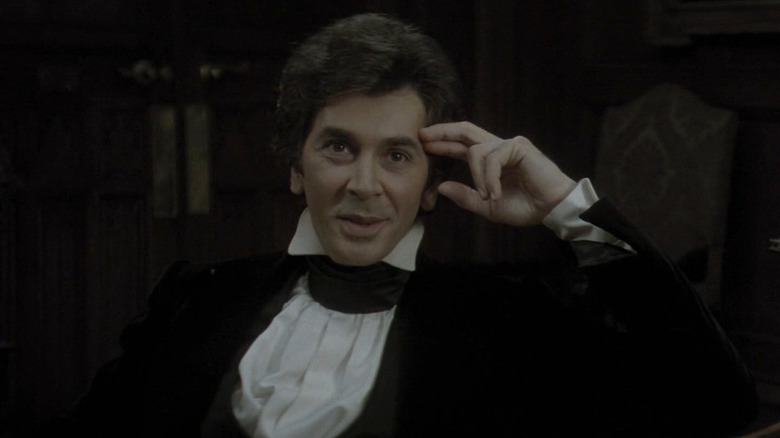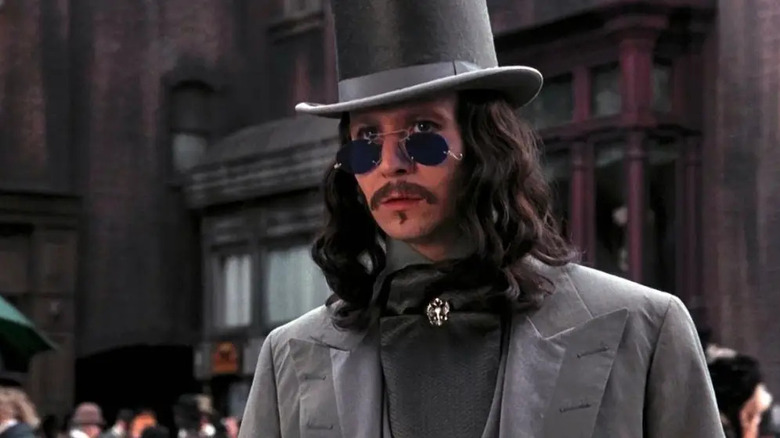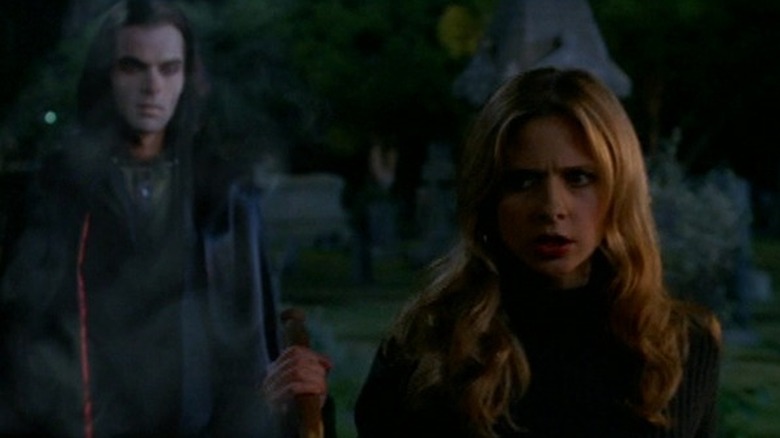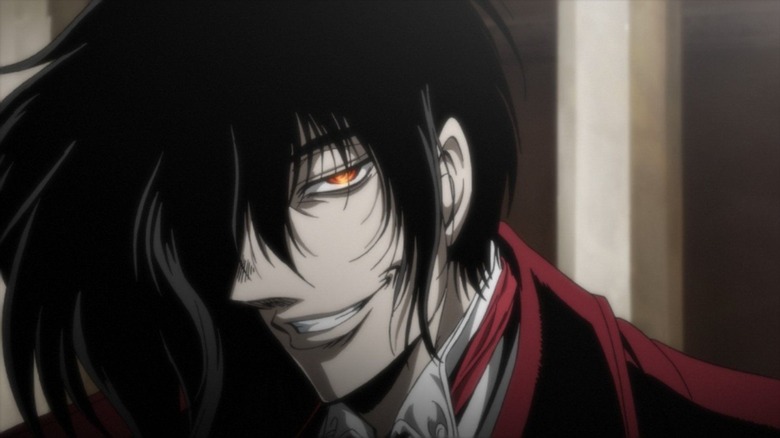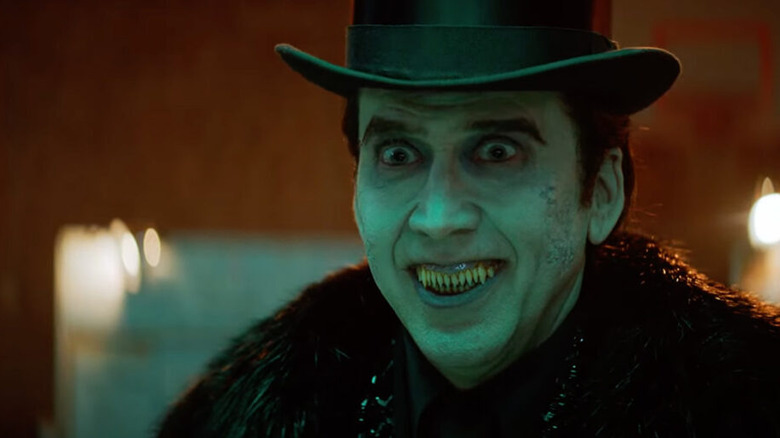How Does Nicolas Cage's Dracula Measure Up? A Horrifying Investigation
If there was anything about "Renfield" worth getting excited for, it was Nicolas Cage playing Dracula. Though the movie sadly sucks, he's genuinely good. It's not even an out-there performance destined to be made into memes like the kind Cage has become infamous for. Cage is the only one in "Renfield" acting like he's in a horror movie and is thus the only one with a compelling screen presence. Frankly, I'd rather see a straightforward Dracula movie starring him than have him stuck in the confused schlock that is "Renfield."
Cage is the latest in a long line of silver-screen Draculas, so how does he stack up? Ranking Count Dracula performances can be difficult because different actors and storytellers interpret the character differently. Depending on the movie, he can be a hero or a villain. Is Dracula a foreign invader, a tragic romantic, or a bloodthirsty monster? Let's look at the different answers offered by decades' worth of movies and TV.
The shadow of Bela Lugosi
The defining Dracula performance is without a doubt Bela Lugosi's, originating with the 1931 Universal Horror "Dracula." Directed by Tod Browning, the film was made only three decades after Bram Stoker wrote the original novel. For the vast majority of Dracula's history, Lugosi has been what people picture when they envision the character.
Lugosi first played the Count on Broadway; he was a Romanian immigrant — born in Transylvania, no less — so his natural accent added authenticity. Lugosi's voice is smooth but never sleazy. Between that, his hungry smile, and his piercing eyes (which the film often literally spotlights), it's hard not to be hypnotized — and plenty of the audience was. Lugosi's sex symbol status went to his head, so much so it's believed to be one reason he turned down the part of Frankenstein's Monster.
Lugosi's performance is such a cultural fixture, and so subject to caricature, that it's hard to judge on its own terms. Take a moment and just think of all the bad "I vant to suck your blood" impressions you've heard from lesser actors. What remains striking is the way Lugosi melds scariness and sex appeal. The way he holds his clawed arm out is like a predator, both ravenous and lascivious. Subsequent Draculas would usually choose one side over the other.
The romantics
Vampires are inherently sexual creatures; their way of biting their prey's neck is often conflated with a different kind of carnal penetration. Some "Dracula" adaptations understand this all too well and wind up so enamored with the Count, they make him more man than monster. Foremost is John Badham's 1979 "Dracula" starring Frank Langella.
Langella has said he resisted pressure to add the more violent aspects of Dracula to his performance — no bloodstains or fangs for this Count. Langella explained, "I just wanted to play what I believed was a lover, not a killer."
The result is the most human Dracula, one with a kind face and wide eyes. Unlike Lugosi, there's never a hint of insincerity in Langella's politeness or smile and he lacks the evil twinkle in his eye. When Dracula enters the Van Helsing household, he works the room like a gentleman. He does say the famous, "I never drink ... wine" line, but gone is any hint of him toying with his prey. In short, you'd never guess that Langella's Dracula is a bloodsucking fiend — which makes it all the scarier that he is.
Gary Oldman's tragic hero
My favorite Dracula film is the 1992 "Bram Stoker's Dracula," directed by Francis Ford Coppola. The Count is played by Gary Oldman, who is the most complete and multi-dimensional Dracula. Indeed, his appearance literally transforms over the course of the film; he goes from long-haired prince to old crone and back again.
This adaptation, otherwise rather faithful to the book, adds a prologue showing Dracula's mortal life as Vlad Tepes. After defeating an invasion by the Ottoman Empire, Vlad's enemies send false word to his bride Elisabeta (Winona Ryder) that her knight died in battle; she throws herself to her death. Outraged that this is his reward for defending Christendom, Vlad renounces God, vowing to rise again and do the Devil's work.
Oldman adopts a Romanian drawl when playing the Count. No matter whether he's acting scary or seductive, there's a ping of sadness in his voice. Then he meets Mina Murray, the reincarnation of Elisabeta (also played by Winona Ryder). In the novel, Dracula's wooing of Mina was simply a predator stalking his natural prey, but here it's a genuine and reciprocated romance. "I have crossed oceans of time to find you," one of the purest declarations of love I've ever heard, straight from the mouth of a blackhearted demon.
When Dracula receives word that Mina has married Jonathan Harker (Keanu Reeves), he does something no previous onscreen Dracula had done; he cries, his face turning monstrous as tears of blood fall down it. Dracula is a man who cannot die yet is always stuck in the past.
Buffy's Dracula
"Buffy The Vampire Slayer" featured the Count as a guest villain in its season 5 premiere, aptly titled "Buffy vs. Dracula." This Dracula, played by German actor Rudolf Martin, has powers no other vampire in the series does; like in Stoker's novel, he can hypnotize his prey or shapeshift into mist, a bat, or a wolf. He puts the former skill to work on Xander Harris (Nicholas Brendon), turning him into a new Renfield (complete with a craving for bugs).
Though unmistakenly a villain, Martin's Dracula feels influenced by Oldman's, from the flowing hair to the romantic bent. He's in Sunnydale to win the heart of the Slayer (Sarah Michelle Gellar), and thanks to his "dark, penetrating eyes," he just might succeed. The episode even does its own spin on a classic Dracula scene; he sneaks into a woman's bedroom at night and seduces her until she offers her neck for him to bite. Even Buffy's willpower isn't enough to resist.
With about 15 minutes of screentime, Martin's Dracula doesn't get enough focus to be one of the best — he's competing with some bona fide acting legends too. However, as a villain of the week in what's essentially a cover tribute, he gets the job done. And he is genuinely alluring, so you understand why he gets inside Buffy's head.
The monsters
The runner-up to Legosi for the most famous Dracula actor is Sir Christopher Lee. He played the Count in Hammer Films' mid-20th century revival of the "Dracula" film series. Lee's Dracula was more a silent creature of the night; he let his physical presence define the role.
With a narrow 6'5 frame, Lee was often taller than his co-stars, which added to his menace. When Dracula stands still in perfectly shadowed frames, his cape engulfing his body, he looks more like a shadow than a person. Low-angle shots add to his already imposing height too.
Then, he starts to move, usually slowly backing his prey into a corner until he towers over them. Lee's stare is chilling and the lighting is always sure to let the shadows bring out his eyes. Take the terrifying close-up in the original "Horror of Dracula," where the Count bares his blood-soaked fangs with a hiss. With that one image, Lee's Dracula was more savage than Lugosi's ever was.
Lee's Dracula doesn't lack sexuality — take the scene in "Dracula: Prince of Darkness" when he bares his chest, draws blood from it, and almost makes female lead Diana (Suzanne Farmer) drink from the wound. Still, he's so spine-chillingly scary that fright overpowers desire. You can understand being ensnared by Christopher Lee's Dracula, yet you never forget that if you do, it'll be your end.
Nosferatu
In 1922, German filmmaker F.W. Murnau directed the silent film "Nosferatu," an authorized adaptation of "Dracula" with the character names changed: Max Shreck played the vampire, Count Orlok. Despite legal action from the Stoker estate, the now-century-old "Nosferatu" remains an influential vampire movie classic. It was even remade in 1979 by Werner Herzog, with the proper character names restored. Hutter was again Harker (Bruno Ganz), Ellen was again Lucy (Isabella Adjani), and Orlok was again Dracula (Klaus Kinski).
Despite being called Dracula, the character in Herzog's film keeps Shreck's look as Orlok; bald, grey-skinned, and with pointed ears. This makes him look far more monstrous than other Draculas, yet he's actually a pitiable character. Kinski's Dracula is the most pathetic one; his appearance isn't intended to make him look scarier but emphasize his distance from humanity. The film recreates the original moment of him invading Lucy's bedroom, but here it's because he's desperate for a connection with another person. Being a monster didn't devour this Nosferatu's soul, but chipped away at it.
Two performances, same character
Not all Dracula performances are in live-action. The anime "Hellsing" (that "Renfield" wishes it was) stars Alucard, a tamed version of the Prince of Vampires who now serves the Church of England. Alucard is a monster — he'd be the first to admit it — it's just that he's been directed to fight even greater evils. That's the irony; "Hellsing" is the rare story where Dracula is the outright hero, yet it never downplays how vile he can be.
In the original Japanese, Alucard is voiced by Jouji Nakata, while in the English dub, Crispin Freeman filled in. The differences in their performances and vocal timbre are a further testament to how flexible the character Dracula is. Nakata's voice is older, calmer, and booming; Alucard sounds like a bemused immortal who never loses his cool. While Freeman has a baritone too, his mellifluous voice is younger and sexier, meaning his Alucard is more seductive than Nakata's. Both Alucards are scary, but while Freeman sounds crazy, Nakata always sounds totally in control. No matter the medium a story is told in or the language its performers speak, the power of Dracula shines through.
Where does Cage fall?
Nicolas Cage's Dracula definitely falls into the "monster" category. He's evil, no two ways about it, and doesn't bother with any pretense of politeness. He's rude, sadistic, and above all hungry. As a result, Cage is the least sexy Dracula next to Kinski — his trying to seduce Rebecca (Awkwafina) is his weakest moment.
The whole point of the film is to illustrate that Renfield (Nicolas Hoult) is in a toxic relationship with his master, so playing up Dracula's bad side makes sense. The portrayal also fits with Cage's inspiration for the role. "Renfield" is supposedly a sequel to the 1931 "Dracula" — an early black-and-white sequence even recreates Lugosi's introduction with Cage swapped in. However, Cage has said Christopher Lee is the Dracula he pulled the most from. Much like the diminishing returns of the Hammer Dracula sequels, the film doesn't do enough to service Cage's performance.
Christopher Lee had one of the most powerful voices ever bestowed upon a mortal man, yet Hammer's "Dracula" movies rarely let him speak. In "Horror of Dracula," his dialogue is all in the first scene where he meets Harker (John Van Eyssen). He's a perfect gentleman which makes his silence all the more striking. According to Lee, he wished to perform Stoker's dialogue but was often dismissed by the studio. So, he just said nothing at all.
Cage honors Lee's Dracula legacy by elevating a thin villain with pure menace. If only "Renfield" let him be as scary as he's capable of being, then he might be one of the greatest onscreen Draculas. As it stands, he'll probably have to sit at the bottom of the top 10.


